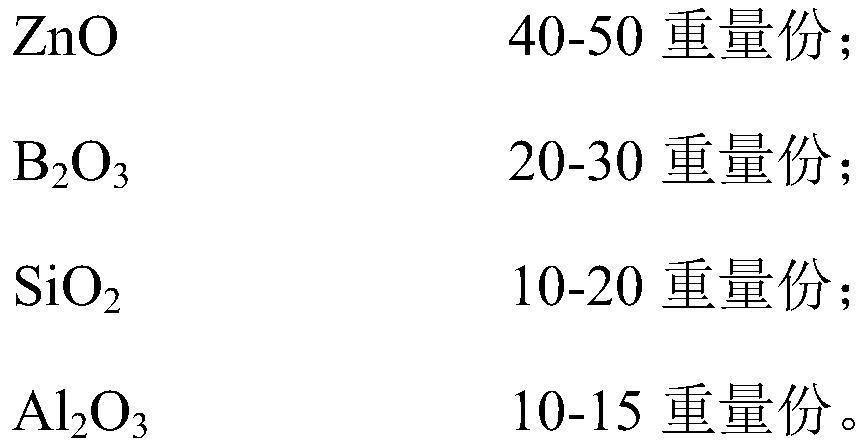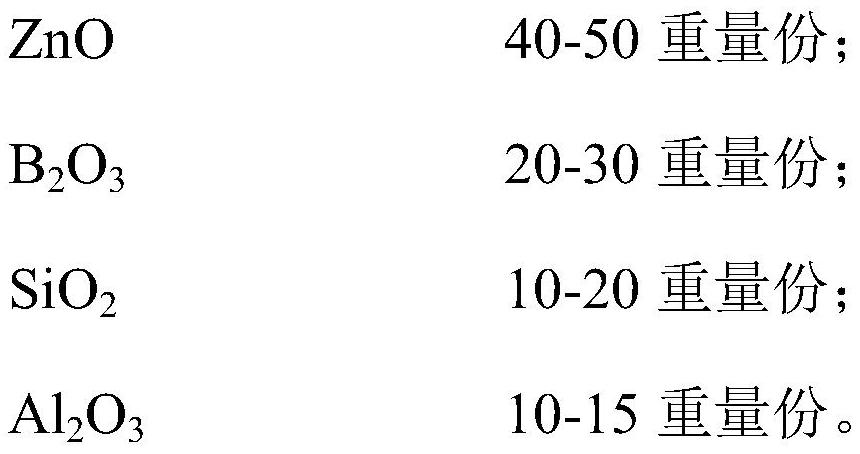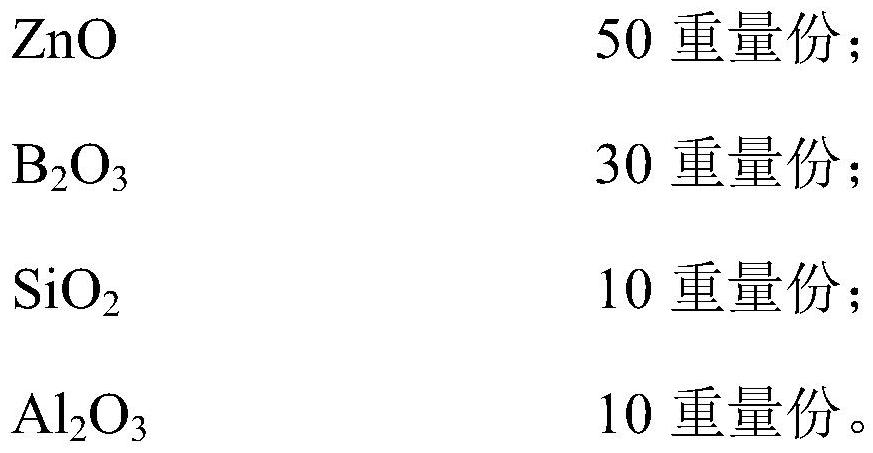Low-temperature co-fired ceramic material and preparation method thereof
A technology of low-temperature co-fired ceramics and slurry, applied in the field of low-temperature co-fired ceramic materials, which can solve problems such as excessively high resonance frequency temperature coefficient and low dielectric loss, achieve low dielectric loss and improve low-temperature sintering performance
- Summary
- Abstract
- Description
- Claims
- Application Information
AI Technical Summary
Problems solved by technology
Method used
Image
Examples
Embodiment 1
[0051] The low-temperature co-fired ceramic material described in this embodiment, in terms of the total amount of its preparation raw materials, includes the following components in mass content:
[0052] BaTi 4 O 9 55wt%;
[0053] Mg 2 SiO 4 15wt%;
[0054] Low melting point glass powder 30wt%;
[0055] Wherein, the low melting point glass powder includes the following components by weight:
[0056]
[0057] The preparation method of the low-temperature co-fired ceramic material described in this embodiment includes the following steps:
[0058] (1) According to the selected stoichiometric ratio, weigh the corresponding weight of BaCO 3 , TiO 2 , adding water (material: water = 1: 1.2) and ammonium acrylate dispersant (accounting for 0.7wt% of the powder) and mixing, using a ball mill for pre-mixing for 3h, and after ball milling, using a horizontal sand mill (The grinding medium adopts 0.65mm zirconium balls) for further dispersion to obtain a uniformly disper...
Embodiment 2
[0068] The low-temperature co-fired ceramic material described in this embodiment, in terms of the total amount of its preparation raw materials, includes the following components in mass content:
[0069] BaTi 4 O 9 70wt%;
[0070] Mg 2 SiO 4 5wt%;
[0071] Low melting point glass powder 25wt%;
[0072] Wherein, the low melting point glass powder includes the following components by weight:
[0073]
[0074] BaTi described in this example 4 O 9 The preparation method of the base low temperature co-fired ceramic material comprises the following steps:
[0075] (1) According to the selected stoichiometric ratio, weigh the corresponding weight of BaCO 3 , TiO 2 , adding water (material: water = 1: 1.2) and ammonium acrylate dispersant (accounting for 0.8wt% of the powder) and mixing, using a ball mill for pre-mixing for 3h, and after ball milling, using a horizontal sand mill (The grinding medium adopts 0.65mm zirconium balls) for further dispersion to obtain a u...
Embodiment 3
[0083] The low-temperature co-fired ceramic material described in this embodiment, in terms of the total amount of its preparation raw materials, includes the following components in mass content:
[0084] BaTi 4 O 9 65wt%;
[0085] Mg 2 SiO 4 15wt%;
[0086] Low melting point glass powder 20wt%;
[0087] Wherein, the low melting point glass powder includes the following components by weight:
[0088]
[0089] The preparation method of the low-temperature co-fired ceramic material described in this embodiment includes the following steps:
[0090] (1) According to the selected stoichiometric ratio, weigh the corresponding weight of BaCO 3 , TiO 2 , adding water (material: water = 1: 1.3) and ammonium acrylate dispersant (accounting for 0.9wt% of the powder) and mixing, using a ball mill for pre-mixing for 3h, and after ball milling, using a horizontal sand mill (The grinding medium adopts 0.65mm zirconium balls) for further dispersion to obtain a uniformly disper...
PUM
 Login to View More
Login to View More Abstract
Description
Claims
Application Information
 Login to View More
Login to View More - Generate Ideas
- Intellectual Property
- Life Sciences
- Materials
- Tech Scout
- Unparalleled Data Quality
- Higher Quality Content
- 60% Fewer Hallucinations
Browse by: Latest US Patents, China's latest patents, Technical Efficacy Thesaurus, Application Domain, Technology Topic, Popular Technical Reports.
© 2025 PatSnap. All rights reserved.Legal|Privacy policy|Modern Slavery Act Transparency Statement|Sitemap|About US| Contact US: help@patsnap.com



